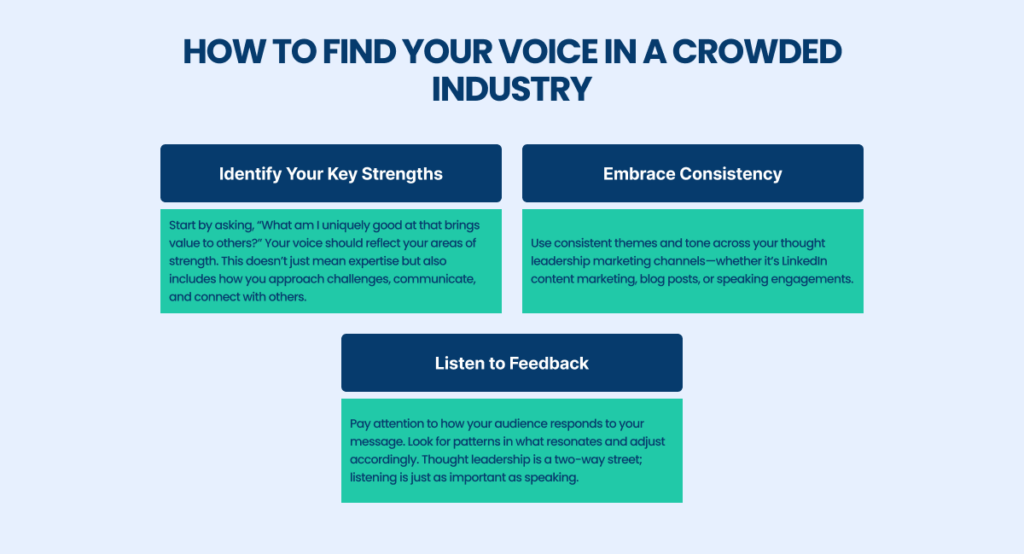What separates the ordinary from the extraordinary?
What sets industry leaders apart from the rest? The answer lies in thought leadership.
Denise Brosseau, CEO and co-founder of Thought Leadership Lab, also outlines that “Thought leadership is not about being known for knowing something. It’s about being known for making a difference.”
In today’s competitive landscape, thought leaders do more than simply share expertise—they inspire trust, drive meaningful change, and elevate the conversation.

The statistics show the importance of thought leadership in establishing brand recognition and credibility, particularly for emerging companies.
An expert Thought Leadership Agency will set the foundation for your brand to gain visibility and be recognized as a trusted authority in your field.
The blog post will cover the five essential steps to becoming a thought leader.
1. Are You Ready to Lead with Purpose?
When we talk about thought leadership, we’re not just referring to expertise. Expertise alone doesn’t always lead to influence.
True thought leadership goes beyond being “good at what you do” and aims for something far more profound: leading with purpose to create lasting change.
Thought Leadership: More Than Just Knowledge
Thought leadership is about being the person others turn to for insights, inspiration, and direction. It’s about crafting solutions, sparking ideas, and leaving a lasting impact. While many may focus on simply knowing their field well, a true thought leader focuses on why they contribute to the field and how they can help shape it.
Source: Brighttall
By leading with purpose, you can transform knowledge into something actionable, relatable, and above all, impactful.
Imagine the difference between simply giving advice versus inspiring someone to change how they think. Thought leaders go for the latter. They’re not in it to win arguments or impress with jargon; they’re in it to create solutions, provoke thought, and spark action. Think about how that looks in real life:
- Simon Sinek, with his focus on the “why,” has inspired countless organizations to rethink their approach to leadership and brand-building.
- Arianna Huffington has built her brand on promoting wellness and redefining success, influencing how industries view work-life balance.
These leaders didn’t just showcase knowledge—they infused it with purpose, changing how we think, work, and lead.
The Purpose-Driven Advantage
How to become a thought leader starts with leading with purpose, which offers clear advantages, especially in today’s world where brand reputation and authority marketing are crucial.
Statistics show that 53% of buyers say it’s important for new and small companies to produce thought leadership if they want buyers to consider working with them.
Thought leadership, done right, boosts credibility, drives influence, and can even shape industry standards. But to do this, your leadership needs to stand out as intentional and focused on positive change. Here’s why that matters:
- Purpose resonates with people – Customers, clients, and teams are increasingly drawn to leaders who stand for something meaningful.
- Purpose establishes trust – When you’re clear about your stand, people will likely see you as authentic and trustworthy.
- Purpose sustains relevance – Thought leaders who lead with purpose are adaptable and stay connected to what matters to their audience.
2. Find Your Unique Perspective: What Can Only You Bring to the Table?
How to become a thought leader requires more than just expertise—you need a unique perspective. This is the foundation of your personal brand and the backbone of your message.
In a world crowded with experts, your distinct viewpoint can set you apart, adding depth to your brand reputation and reinforcing your authority marketing efforts.
Why Your Unique Perspective Matters for Thought Leadership
For CEOs and business owners, leading with a unique perspective isn’t just about being different for the sake of it. It’s about identifying what you uniquely bring to the industry.
This individuality attracts attention and builds brand credibility, especially when your insights resonate with others’ real-world challenges. By providing a fresh angle, you make a memorable impression that can inspire others to follow your lead.
For example, think of industry giants like Elon Musk or Warren Buffet. They aren’t just known for their accomplishments—they’re known for how they think. Their viewpoints shape their industries and draw followers who trust their vision.
Crafting Your Own Unique Message
To create a perspective that genuinely stands out, start by reflecting on these areas:
- Core Values: What values guide your business and personal decision-making? Your values form the backbone of your leadership. Consider what principles set you apart from others in your industry.
- Unconventional Wisdom: What “truths” do you believe that others may overlook or ignore? A unique perspective often involves challenging the status quo. This doesn’t mean you must be provocative, but it does mean you need a viewpoint that isn’t widely shared.
- Personal Experiences: Reflect on your career path, mistakes, and breakthroughs. Your journey shapes your insight. Ask yourself what lessons you’ve learned that only someone in your position would understand.
How to Find Your Voice in a Crowded Industry
How to become a thought leader starts with finding your unique voice in a crowded industry. In a saturated market, simply sharing knowledge isn’t enough.
To make an impact, you need a clear voice that breaks through the noise. Your voice is the unique lens through which you view your industry and communicate your insights.

3. Create Content that Resonates: Stories, Solutions, and Strategic Insights
If you’re wondering how to become a thought leader, crafting content that resonates with your audience is essential.
One of the best ways to engage is through storytelling, which builds an emotional connection and makes your insights relatable. Great stories resonate with people’s experiences, challenges, and dreams.
As a thought leader, your stories can do more than inform—they can inspire action.
How to Tell Stories that Build Trust and Inspire Action
Storytelling goes beyond sharing information; it’s about connecting with your audience on a deeper level.
Source: Redline
When people relate to your stories, they’re more likely to see you as a trusted leader and expert.
- Share Personal Experiences
One of the simplest ways to connect is by sharing your own journey. Talk about challenges you’ve overcome, lessons you’ve learned, or pivotal moments in your career. When CEOs and business owners reveal personal insights, it humanizes their brand and makes their advice feel grounded.
Example: Consider how Howard Schultz, former CEO of Starbucks, often shares his story of growing up in poverty. His journey to creating one of the world’s largest coffee companies isn’t just inspiring—it’s relatable and establishes brand credibility.
- Incorporate Client Success Stories
Stories about your clients’ successes provide concrete examples of your impact. They demonstrate real-world results and reinforce trust.
If you have examples of clients who have achieved their goals with your guidance or product, share these stories to illustrate how your insights have helped others.
- What to Include: Highlight the problem, the process, and the result. Use metrics or qualitative feedback where possible to show the success. This gives prospective clients a tangible sense of the value you can offer.
- Offer Strategic Insights with Practical Applications
Your insights don’t need to be purely theoretical. CEOs and business owners appreciate strategies they can implement.
When you share strategic insights, connect them to real actions. Answer questions like “How can I apply this in my business?” or “What steps can I take to see similar results?”
- Example: A CEO who pioneered a new digital transformation leadership model might share their approach to integrating technology across departments. By detailing their steps, the hurdles they faced, and the benefits gained, they make their story actionable and relevant.
- Tap into Authority Marketing through Data-Driven Insights
For authority marketing to be effective, back your stories with data when possible. Business leaders value insights grounded in numbers or supported by research. Use relevant statistics to enhance the credibility of your stories. For instance, sharing that “60% of executives say storytelling helps build trust with their audience” can underscore why your storytelling efforts matter.
Tip: Avoid making your stories feel like a sales pitch. Thought leadership is about providing value without an immediate expectation of a return. Focus on helping your audience first, and the impact on brand reputation will follow.
4. Build and Engage Your Community: Conversations Beyond Content
As a thought leader, your impact grows not only from the content you share but from the connections you cultivate. It’s about more than posting on LinkedIn or writing a compelling article; it’s about engaging beyond the screen and building a real connection with your audience.
By fostering genuine engagement, you develop a community that values your insights, trusts your guidance, and ultimately amplifies your voice.
Source: RedLine
Engaging Beyond the Screen: Building a Real Connection with Your Audience
A strong thought leader doesn’t just broadcast ideas—they join the conversation, making a difference by actively participating in discussions that matter to their followers.
- Engage Authentically on Social Platforms
Platforms like LinkedIn, Reddit, and industry forums aren’t just places to post; they’re spaces for dialogue. Reply thoughtfully to comments, ask questions, and participate in conversations. This engagement shows your audience that you’re more than just an information source—you’re a real person interested in listening and learning.
Example: If someone comments on a LinkedIn post about digital transformation leadership, dive into a meaningful discussion. Share your experiences, ask about their challenges, and offer advice that resonates with their specific situation. This approach humanizes your brand and builds trust.
- Participate in Industry-Specific Forums
Many CEOs and business owners overlook the potential of niche forums to connect with a dedicated audience. Industry-specific platforms or groups on sites like Quora, Reddit, or specialized communities can be goldmines for fostering loyal followers. Participating in these conversations provides insights into your audience’s pain points and challenges, helping you tailor your content and approach.
Tip: Look for questions that relate to your expertise, respond with thoughtful, value-driven insights, and avoid sounding overly promotional. This establishes you as a credible authority who is genuinely there to help.
- Host or Join Live Events and Webinars
While social media posts are valuable, live interactions like webinars, Q&A sessions, and even podcast appearances allow you to directly engage with your audience, creating a deeper connection. Hosting or participating in these events gives your audience a chance to see your thought leadership in action and ask questions, making the experience more personal.
- Bring Personality to Your Personal Brand
Personal branding strategies succeed when you show who you are beyond the business. Sharing behind-the-scenes stories, challenges you’re tackling, or personal anecdotes not only enriches your brand credibility but also helps your audience relate to you on a human level. This authenticity is often what turns followers into a community.
- Cultivate Conversations, Not Just Followers
A community is stronger than a following. Encourage discussions by asking your audience for their thoughts, experiences, or solutions to industry challenges. For instance, you might create a LinkedIn post about a trend in authority marketing and ask your followers how they’re approaching it in their own businesses. This builds a sense of belonging among your followers,
5. Measure and Refine Your Impact: Is Your Thought Leadership Working?
For thought leadership to have lasting value, you need to assess if you’re making a real difference. It’s not enough to publish content; understanding how to become a thought leader involves evaluating how that content impacts your brand, influences your audience, and generates new opportunities.
By tracking essential metrics, you can refine your approach, focusing on strategies that resonate with your audience and support your thought leadership goals.
How to Know if You’re Making a Difference
Success in thought leadership marketing isn’t just about views or likes—it’s about creating a lasting impact. Let’s explore how to gauge whether your thought leadership efforts are truly effective.
1. Track Audience Engagement and Interaction
Are people interacting with your content or just scrolling past? Metrics like comments, shares, and time spent on the page indicate how deeply your audience engages with your ideas. For instance, thought leadership examples on LinkedIn show that posts with high interaction levels (likes, comments, shares) are often perceived as more credible and valuable.
- Comments and Conversations: Look for recurring questions, comments, or points of interest. This shows that your content resonates and reveals topics that are particularly engaging for your audience.
- Shares and Referrals: When people share your content, it demonstrates that they find it valuable enough to pass along, which increases your reach and brand reputation.
2. Monitor Brand Mentions and External References
Beyond your content, it’s essential to know if others are talking about you. Set up alerts to track brand mentions and references on Twitter, LinkedIn, or industry publications. Mentions and backlinks from other thought leaders or industry sites indicate that your insights are respected and sought after, enhancing your authority marketing.
- Example: If you notice increased mentions in niche forums or industry blogs, it’s a sign that your influence is growing beyond your immediate network.
3. Evaluate Lead Generation and Conversion Rates
While brand building is an essential part of thought leadership, generating tangible business results is also critical. Track metrics like lead generation, form submissions, newsletter sign-ups, and other actions that indicate potential client interest.
4, Track New Opportunities: Speaking Invitations and Collaborations
One of the strongest indicators of thought leadership success is when new opportunities come to you. Invitations to speak at industry events, requests for podcast interviews, and collaboration offers are powerful signs that your message is making an impact.
- For example, a CEO who consistently publishes insightful LinkedIn content might be invited to speak at a digital transformation conference. This is a direct outcome of the thought leadership they’ve built online.
Final Thoughts: Keeping Your Voice Relevant and Fresh
Thought leadership is a journey, not a destination. By actively engaging your audience and measuring your impact, you’re not only building a following—you’re building a legacy.
[A] Growth Agency knows the unique power that comes from inspiring others and leading with authenticity.
We specialize in helping business owners, CEOs, and industry pioneers carve out a space in crowded markets, not just to be seen but to be trusted voices in your field.
Excellence is our standard. We believe in the power of data to inform and drive every strategy, ensuring our actions are as effective as they are innovative.
Remember that we put precision and purpose behind every initiative.
Let’s Get Started Together.

